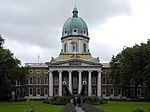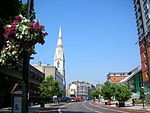Dog and Duck, St George's Fields
Buildings and structures demolished in 1812Commercial buildings completed in the 17th centuryDemolished buildings and structures in LondonFormer pubs in LondonHistory of the London Borough of Southwark ... and 3 more
Pubs in the London Borough of SouthwarkSpasUse British English from July 2013

The Dog and Duck was a tavern built upon St George's Fields in London in the 17th century. It was named after the sport of duck-baiting, that took place in adjacent wetland. In the 18th century its gardens were used as a spa but, by the 1770s, with spas no longer fashionable, it declined into a rowdy location for concerts. The magistrates refused to renew its licence, despite protracted legal disputes, and it closed in 1799. The building was then used as a School for the Indigent Blind and demolished in 1812, when the new Bethlem Hospital was built upon the site. That building is now used by the Imperial War Museum.
Excerpt from the Wikipedia article Dog and Duck, St George's Fields (License: CC BY-SA 3.0, Authors, Images).Dog and Duck, St George's Fields
Lambeth Road, London Southwark (London Borough of Southwark)
Geographical coordinates (GPS) Address Phone number Website Nearby Places Show on map
Geographical coordinates (GPS)
| Latitude | Longitude |
|---|---|
| N 51.495555555556 ° | E -0.10861111111111 ° |
Address
Imperial War Museum
Lambeth Road
SE1 6HZ London, Southwark (London Borough of Southwark)
England, United Kingdom
Open on Google Maps








